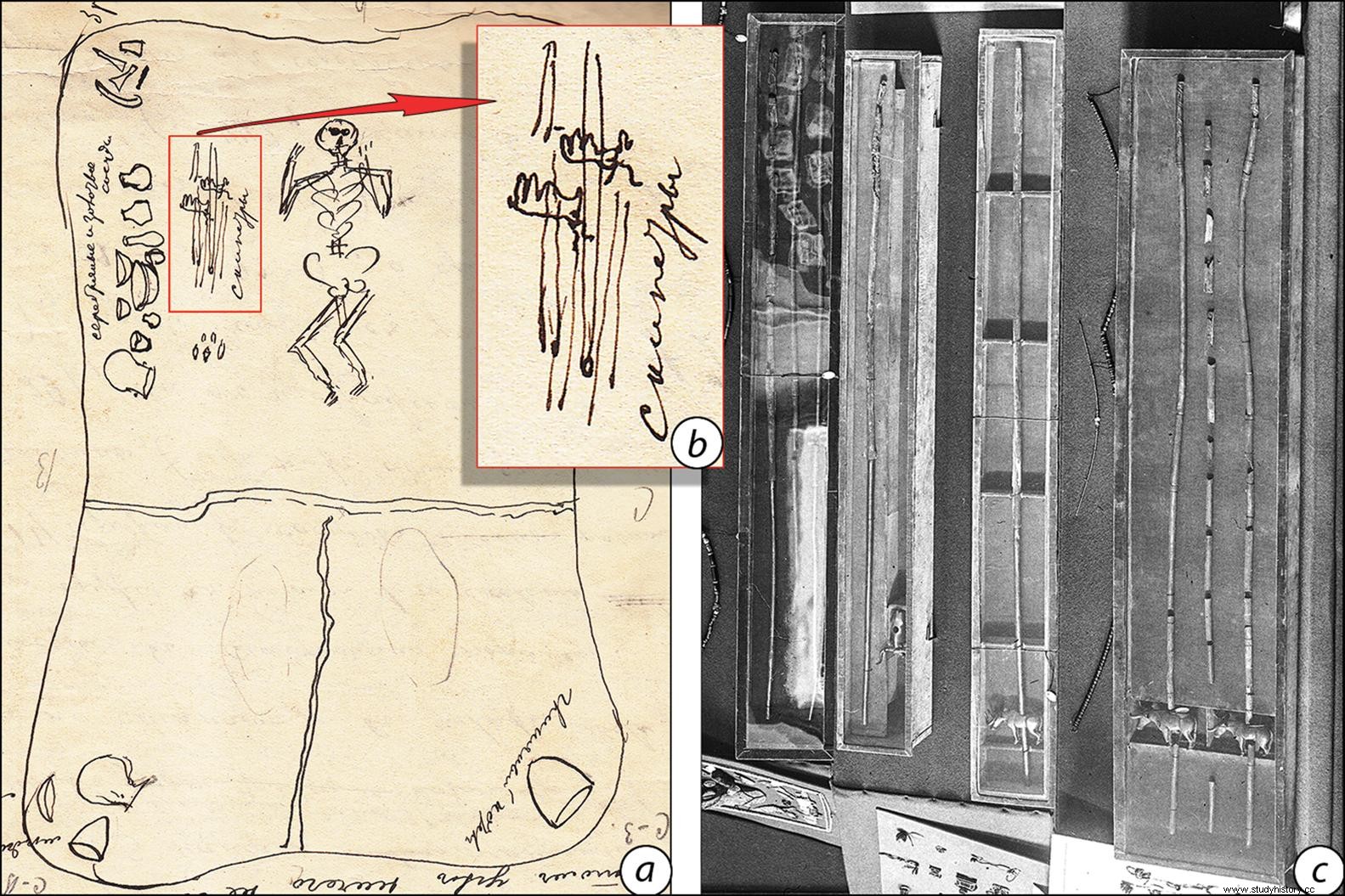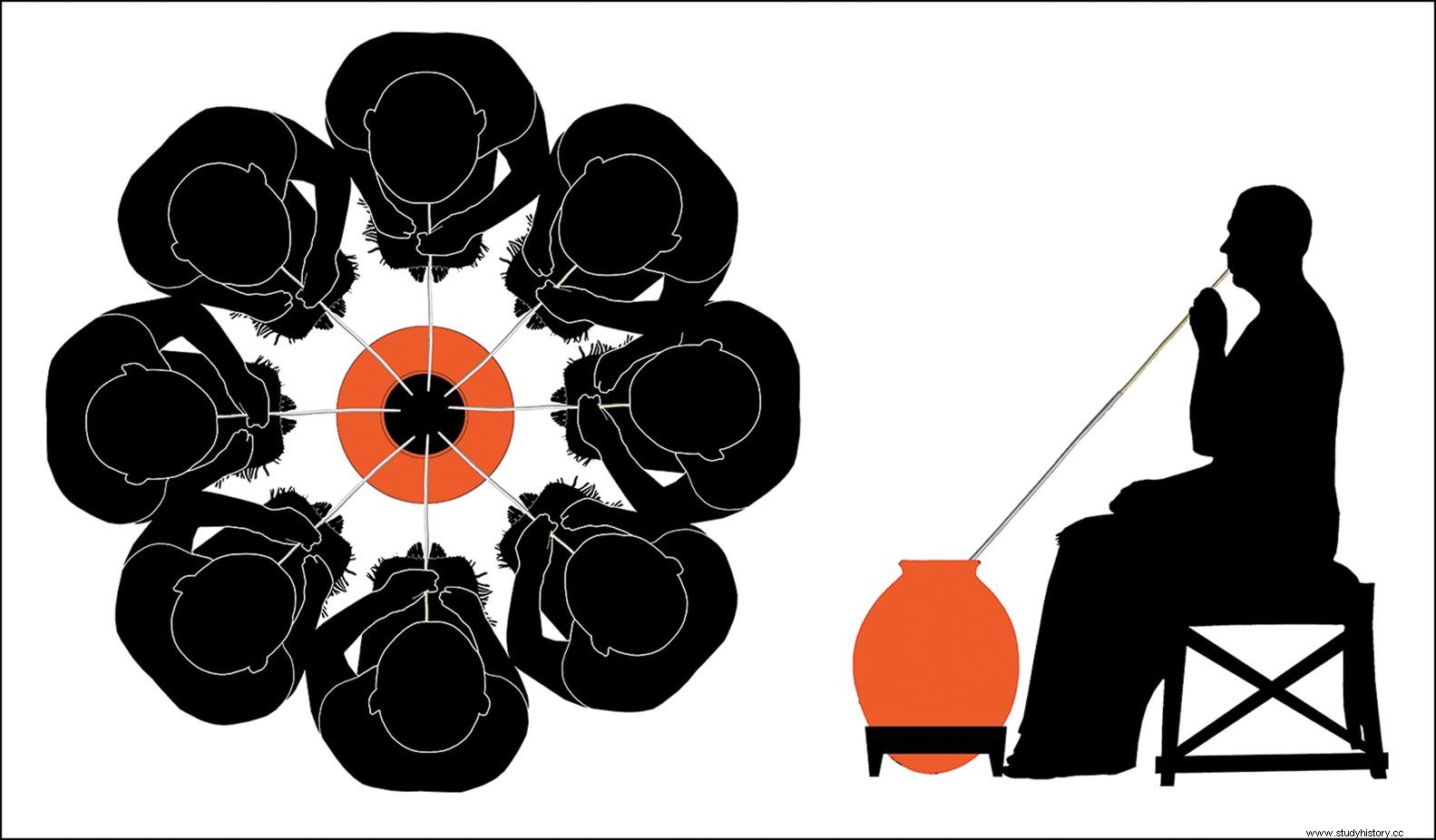It is a series of gold and silver tubes found at the end of the 19th century in a famous tomb in the Caucasus. Their function remained unknown, but we have just understood that they would be large straws allowing, in the Bronze Age, to collectively drink beer. Until now, the rods kept in the Hermitage Museum were considered "sceptres".

A reconstruction showing how the long straws may have been used in common beer drinking.
In the windows of the Hermitage Museum in Saint Petersburg, strange gold and silver rods more than a meter long have been resting for more than a century. They were found in the kurgan of Maykop, one of the most famous elite tombs of the Caucasian Bronze Age. Scepters, archaeologists will say without too much conviction, or perhaps the supports of a canopy. After an in-depth analysis, a Russian team assures that it has finally found the real function of these tubes:it would actually be... straws. They would have been used around 5,500 years ago to drink beer or other liquids from a common jar during banquets. As such, they become the oldest known examples of straw. Their reassessment is the subject of an article published on January 19, 2022 in the journal Antiquity .
A unique place alongside the deceased royal
Eight in number, these tubes with tapered ends were discovered by the orientalist archaeologist Nikolaï Vesselovski in 1897, in the rich tumulus which gave its name to the Maykop culture. The latter developed around 4000 BC in the region of the Russian city of the same name, not far from the Black Sea and the current border with Georgia. It survived until the Early Bronze Age, around 3,700 to 3,000 BC, and was distinguished by its abundance - unusual for this early period - in luxurious objects of bronze, gold and silver. , all found in kurgans .
Kour-what? The kurgan , a term of Tatar origin used in the Russian steppes, the Caucasus and surrounding regions, designates an artificial mound, or tumulus, covering one or more burials. Many are found north of the Black Sea, although they are found throughout Eastern Europe. Attributed to populations who lived in this region from the Neolithic period, they delivered large numbers of gold or silver objects, encouraging a century ago a kind of "treasure hunt" more than a reasoned practice archeology, even in its infancy.

On the left, Veselovsky's sketch of the primary burial made in 1897, showing the position of the eight gold and silver tubes (called "sceptres" in Russian); on the right, the part of the 1898 photograph showing a complete "sceptre" and seven others broken. Credits:St. Petersburg Institute of Material Culture History/Russian Academy of Sciences.
The straws, they were part of the hundred offerings placed in the tomb of three individuals - adults whose bodies, arranged in a fetal position, rested in the same room separated into three sections. The central deceased, who seemed to occupy the most important function considering the higher number of treasures at his side and the rich fabrics with which he was dressed, presented on his right the famous hollow tubes. Even more surprisingly, these tubes were the only objects to rest near the body, when other artifacts, such as ceramics, metal cups, weapons and tools, were confined along the wall. Enough to lead Veselovsky to think that he was holding a series of scepters there.
From scepter to straw
The whole remains however quite enigmatic:on the eight rods made of rolled strips of silver and gold, measuring one meter in length and barely one centimeter in width (5 millimeters on average for the hole), four of they are adorned with a small detachable bull figurine. Never mind:in the fall of 1898, the treasures of the Maykop kurgan were transferred to the Hermitage. Veselovsky presents them to the Tsar's family and special guests at the annual exhibition of the Imperial Archaeological Commission. "Six Scepters" , writes the archaeologist on the description of the objects, which actually appear eight in number on the vintage photograph. In 1914, another archaeologist by the name of Farmakovsky suggested that they were rather supporting rods of an object.

A diagram of the eight reconstructed drinking tubes. Credits:St. Petersburg Institute of Material Culture History/Russian Academy of Sciences
“A major problem with these interpretations is that they overlook the technical details of the tubes or dwell on simplistic explanations about them. They don't answer a simple question:why tubes, and not solid posts? Tubes are much more complex to manufacture" , says Viktor Trifonov, a specialist in Caucasian archeology at the St. Petersburg Institute for the History of Material Culture and first author of the article. The archaeologist raises further questions:"Why were these objects grouped into a set of eight? And what does their deposit mean in this context of the burial ritual?" If Veselovsky and Farmakovsky had known that the tubes contained barley starch residue, lodged in some sort of internal filter, perhaps they could have answered.

The four gold and silver figurines perforated in their center, as if to allow them to be hung on the straws. Credits:St. Petersburg Institute of Material Culture History/Russian Academy of Sciences
"We hypothesize that these items were drinking tubes intended for sipping a type of beverage that required filtration when consumed" , write the researchers, who indeed detected barley starch granules, cereal phytoliths and a linden pollen grain in a sample taken from one of the eight straws. They mention, however, that they cannot exclude external contamination, whether it occurred during the excavations of 1897 or during the conservation of the objects at the Hermitage.
Other examples of drinking tubes in iconography
However, their argument does not stop there:Viktor Trifonov and his team recall, for example, that the oldest representations of drinking beer using a straw date back to the Chalcolithic (from the 5th to the 4th millennium BC). C.) and come from seal impressions found at the site of Gawra XII in northern Iraq and Chogha Mish in western Iran. Furthermore, they point out that in the 3rd millennium BC, banquet scenes showing groups of people sipping beer through long tubes from a common vessel became popular in Mesopotamian art. . "Our interpretation is that a taste for Sumerian luxury and commensality reigned in the Caucasus in the 4th millennium BC."

A schematic reconstruction of the use of straws by members of the nobility of the Maykop culture. Credits:St. Petersburg Institute of Material Culture History/Russian Academy of Sciences
Cross-checking the evidence, the hypothesis is strengthened:"We know that in the 5th and 4th millennia BC, the Neolithic population of the North Caucasus cultivated wheat and barley in abundance. That' was probably also the case for the later Maykop culture, leading us to believe that households may have brewed barley beer flavored with herbs and linden blossoms."
Seen in this light, the set of straws from Maikop's tomb could therefore be the feasting material of eight high-ranking individuals, who in the afterlife would have sat around each other to drink from beer - why not in the single large jar found in the tomb. A 32 liter jar all the same, suggesting that each participant's share was around four liters, or seven pints. This is called having a sense of celebration.
